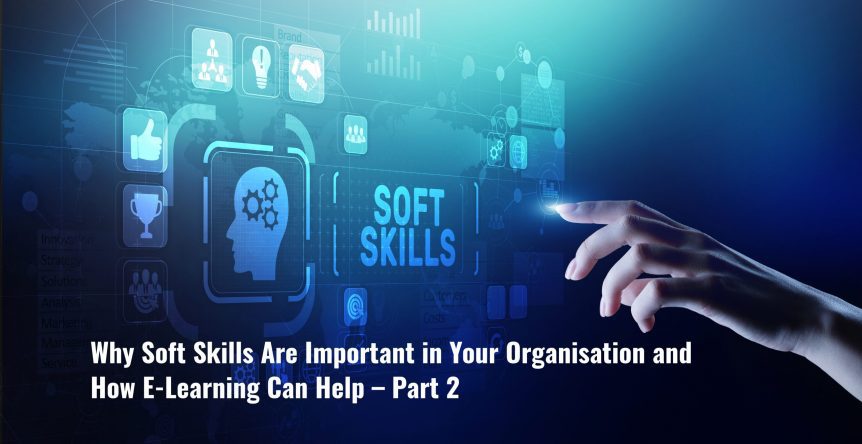Why Soft Skills Are Important in Your Organisation and How E-Learning Can Help – Part 2
In part one of this blog series, we defined the soft skills that are most important in modern businesses and discussed how improving soft skills benefits your organisation.
In this blog, we are going to focus on the delivery of soft skills training and why e-learning should be part of your strategy.
The Main Challenge of Soft Skills Training
Let’s start by looking at the challenges of soft skills training, whether that training is delivered in a classroom, through e-learning, or by another method.
The main challenge is that the process of learning soft skills is open-ended.
This is unlike the process learners go through when learning many hard or technical skills. With hard and technical skills, learners need a level of competence before they can start. Then, once they have gone through the training and have acquired the new skill, the process of training ends.
We can use a very simple example to illustrate this: learning to use a new software application. A person going through this training will need to be competent in using computers before they can start the training. Then, once they’ve gone through the training and learned the software, they don’t need anything further. They can simply start putting the training to use.
With soft skills, however, learners can often begin training at any time. Furthermore, there is no definitive endpoint as soft skills can always be improved.
Other Challenges of Soft Skills Training
In addition to the above, soft skills are also often complex, adding to the challenge of creating effective training.
Not complex in the sense of technically complex, but in the fact that it is impossible to provide training for every situation where a soft skill will be needed.
For example, you could create training for managers on empathy and emotional intelligence, including scenarios and examples in the course content that teaches these skills and demonstrates the benefits.
However, it simply isn’t possible to predict every type of situation where empathy and emotional intelligence skills come to the fore.
One other challenge you may encounter is resistance to soft skills training. People can be set in their ways and often don’t make the connection between a soft skill and how it will help them do their job.
Overcoming the Challenges With E-Learning
You get all the usual benefits of e-learning when you create e-learning soft skills training, i.e. the training is more engaging, it reduces costs, it’s quick to deploy, it ensures consistency, etc.
Using e-learning and following the tips below will also help you overcome many of the challenges of delivering soft skills training.
The Convenience of E-Learning
Some of the main benefits of e-learning include convenience and ease of use. Adapting this to soft skills training, e-learning modules can be easily integrated into an employee’s daily or weekly routine.
This particularly applies if you use a microlearning strategy where learners can complete sections of the course in very short periods of time.
Ideally, you should make it possible for your employees to complete training:
- Where it suits them;
- When it suits them; and,
- At a pace they feel comfortable with.
It is easier to do this with e-learning than with any other training delivery method.
Reducing the Complexity
The best soft skills training is heavily weighted towards practicing rather than knowledge presentation.
You need to present knowledge, of course, but it’s then important to move to practice elements to further embed and clarify the ideas that have been taught.
E-learning is a fantastic tool for this as it is completely safe. Learners can practice the soft skills they have learned using scenarios, interactive videos, and other e-learning elements in an environment that has no impact on business performance or relationships with others.
This gives learners more confidence to try things and make mistakes, all of which are crucial to the learning process.
The Power of Scenarios
It’s important to highlight further how scenarios can be used to enhance soft skills training.
Scenarios let you present a situation to a learner, asking them to take a decision on what to do next. Crucially, however, scenarios don’t have to be linear with only one path for learners to take.
Instead, it is possible to create scenarios in e-learning courses that demonstrate to learners how one action or decision affects the next as well as the ultimate outcome. Importantly, this applies even when the learner makes incorrect choices.
Tips for Using E-Learning to Deliver Soft Skills Training
So, creating e-learning modules will improve soft skills training in your business. What else can you do, however, to make sure the training is a success? Here are some key tips:
- Measure the success of soft skills training with hard metrics and real numbers. You can use anecdotal and observational measurements too but, where possible, use more tangible measurements as well. Examples include improving NPS, reducing staff sickness or turnover, or increasing rates of employee satisfaction.
- Get buy-in and active support from management, including senior managers. This includes ensuring managers at all levels lead by example. For example, there is no point training junior managers in conflict resolution when senior managers either lack or do not value this skill.
- Make sure employees can relate to the content as much as possible. The more relatable the content, the better it will be received by learners.
- Build up a library of e-learning modules that your team can use to continuously improve and develop their soft skills.
Giving Your Business the Edge
Market conditions can change incredibly fast, customers demand more, and the pressure to be more productive and efficient is continuous. Improving the soft skills of your employees is not the only answer to these realities of modern business, but it can give you the edge, improving how you operate and helping you achieve your goals.

